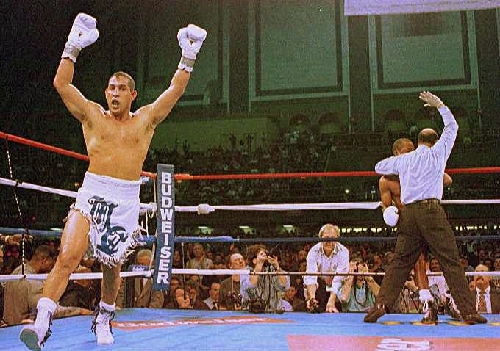Referees recall Camacho’s flair, ‘little tricks’ in ring
"Macho Time" wasn't always a pleasant time whenever Hector Camacho stepped inside a Las Vegas ring to fight.
Some of Camacho's toughest losses during his 28-year professional career came in Nevada. The former world champion, who fought as a super featherweight up to super middleweight, died Saturday after being shot in the face and neck Tuesday in Bayamon, Puerto Rico. He was 50.
Camacho (79-6-3, 38 knockouts) fought seven times in Las Vegas, beginning in 1982 when he outpointed Greg Coverson in a 10-round decision. In 1985, he won the WBC lightweight title with a 12-round unanimous decision over Jose Luis Ramirez at the Riviera.
But that was the highlight of Camacho's time in Southern Nevada. He lost his WBO junior welterweight title to Greg Haugen in 1991 at Caesars Palace in a 12-round split decision. A year later, Camacho came up short against Julio Cesar Chavez at the Thomas & Mack Center, losing a 12-round unanimous decision as Chavez remained WBC junior welterweight champion.
Camacho made two other runs at a world title in Las Vegas, coming up short both times. In 1994, then-IBF welterweight champion Felix Trinidad soundly beat him over 12 rounds at the MGM Grand Garden. In 1997, Oscar De La Hoya dominated Camacho over 12 rounds at the Thomas & Mack to keep his WBC welterweight belt. That was the last time Camacho fought in Las Vegas, where he went 3-4.
Richard Steele and Joe Cortez refereed several of Camacho's fights. They remember a guy who was a skilled fighter but who they also had to watch closely inside the ring.
"He'd try his little tricks," Steele said. "He'd obey my commands, but he'd make you work hard as a referee."
Said Cortez: "I knew his style. He knew all the tricks, but I tried to stay a step ahead of him."
Both referees said Camacho respected them, and they always were impressed by his ability to self-promote and make himself popular with the fans.
"He was a flamboyant guy," Cortez said. "We grew up in the same neighborhood in New York City - Spanish Harlem - and even at an early age, Camacho was going to be special. He just had this way about him."
Said Steele: "He was an exciting fighter. He always wanted to give the fans a show. He was good for boxing."
Cortez worked Camacho's 1994 loss to Trinidad, and he could tell Camacho was past his prime.
"I thought he was losing a step or two when he fought Trinidad," Cortez said. "He wasn't as fast as he was earlier in his career.
"But then he beat Sugar Ray Leonard in '97 when I worked his fight in Atlantic City, and I was amazed how he was able to do that."
Steele, who worked Camacho's 1992 loss to Chavez and his 1997 loss to De La Hoya, also saw a fighter in decline.
"When he started, Camacho fought and trained like a guy who was determined to be a world champion," Steele said. "But he was a shell of a fighter when he fought De La Hoya. I could see he wasn't the same fighter. At that point, he was just trying to pick up a paycheck."
Contact reporter Steve Carp at scarp@reviewjournal.com or 702-387-2913. Follow him on Twitter: @stevecarprj.























